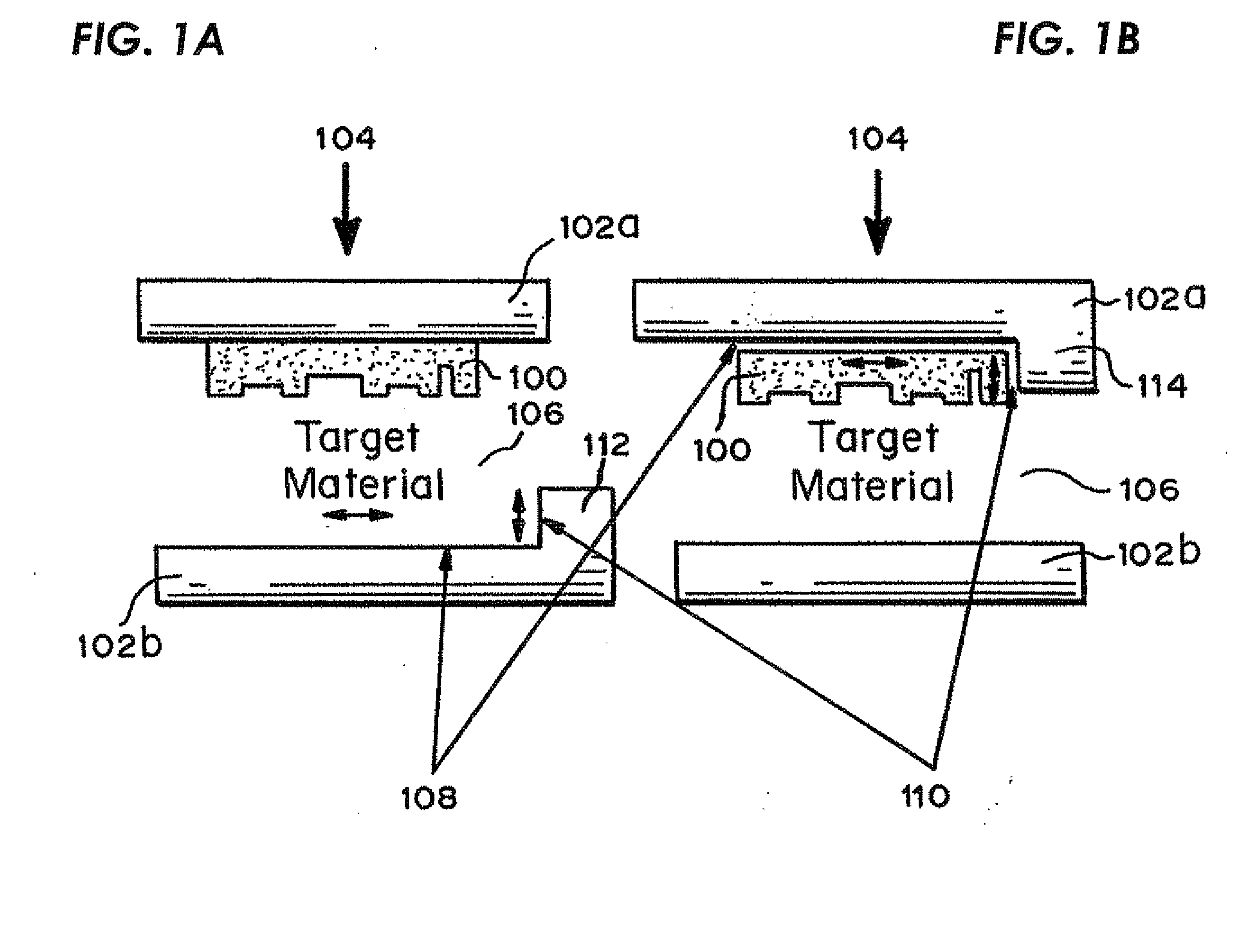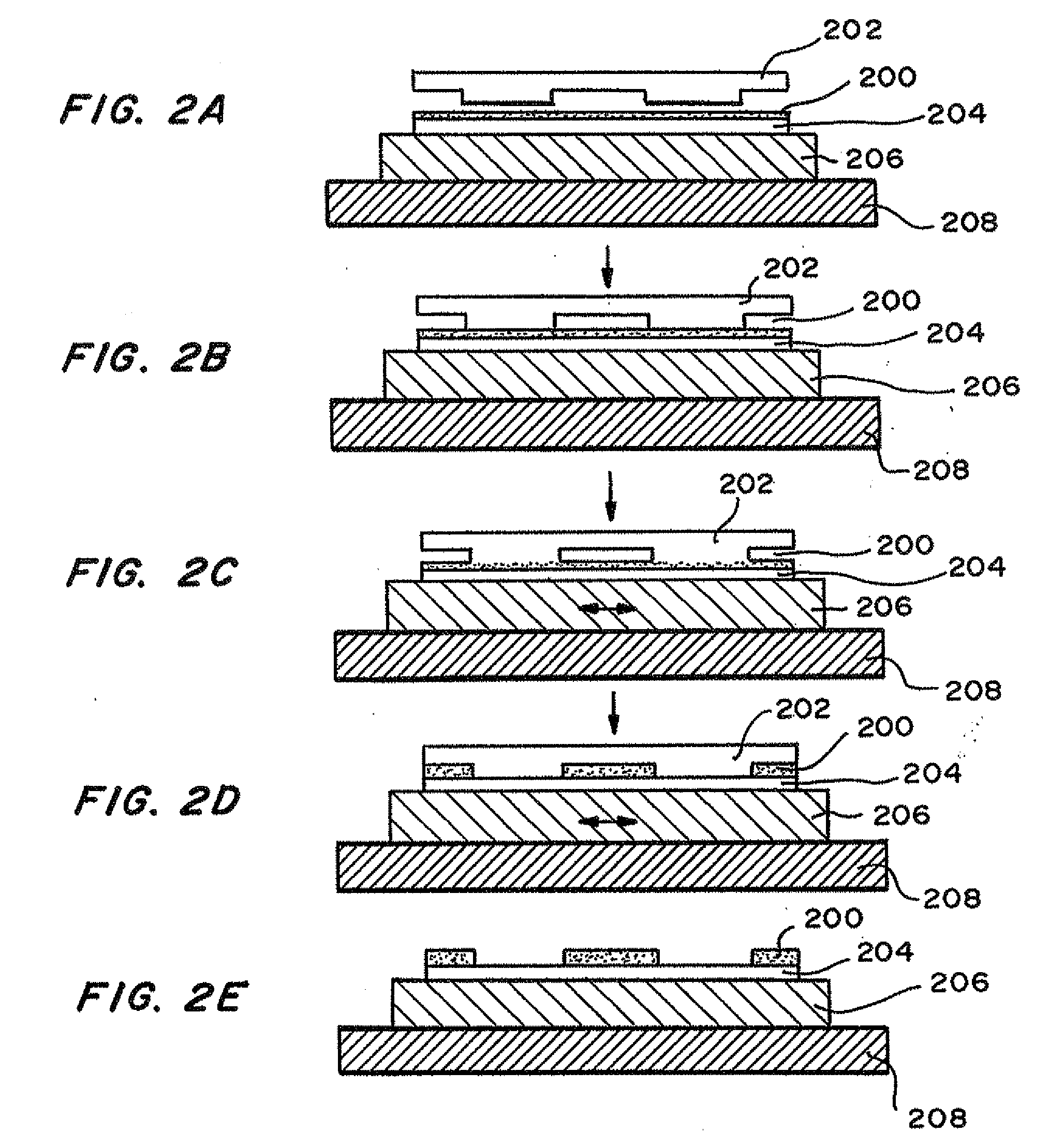Cyclic loading system and methods for forming nanostructures
a nanostructure and loading system technology, applied in the field of nanofabrication and/or microfabrication systems and methods, can solve the problems of limited work performed limited options, and limited work on purely mechanical imprinting techniques
- Summary
- Abstract
- Description
- Claims
- Application Information
AI Technical Summary
Benefits of technology
Problems solved by technology
Method used
Image
Examples
example
Example 1
Shear Based Residual Layer Thinning
[0108]FIGS. 4A and 4B demonstrate shear based residual layer thinning, with an extrusion aspect ration up to 30:1 or more, all at very small lateral shear strains of at most 2%. In this example, a 3 micrometer diameter punch made of silicon thinned an initially 950 nm thick layer of polystyrene from a residual depth (ie. remaining thickness of the film) of 380 nm down to 90 nm according to the amount of oscillating shear force applied. FIG. 4A shows the relative depth of the residual layer (nm) verses the mean relative motion (nmpp). FIG. 4B are atomic force micrographs showing the surface of residual layers and surrounding extruded material that remain after stamp removal for no shear based forming (top) and the maximum (to 90 nm residual thickness) shear based forming. The fine, cross-hatched lines are 60 nm wide replicas of fine, 60 nm wide lines formed on the face of the flat punch used. It can be seen that these fine lines are preserv...
example 2
Residual Film Thickness as a Function of Applied Mean Normal Pressures
[0109]FIG. 5 is a graph of residual film thickness (nm) plotted against piezo drive amplitude (nm), at four different applied mean normal pressures: 75 MPa, 150 MPa, 300 MPa, and 600 MPa. A silicon flat punch of diameter 3 micrometer is used to thin a 950 nm thick film of polystyrene. The graph demonstrates film thinning as a function of applied piezo drive amplitude for each mean normal pressure. As piezo drive amplitude increases, the residual film thickness decreases. The actual stamp-polymer relative motion is about 20% of the drive amplitude, and at most about 1% the width of the stamp.
example 3
Cyclic Shear Loading Improves Extrusion
[0110]A flat punch indented into a 1600 nm polystyrene film to a mean pressure of 550 MPa without oscillation leaves a profile, as shown in FIG. 7. Under the same conditions, but with additional application of lateral sinusoidal loading by applying 10 volts peak-to-peak to a piezoelectric element at a frequency of 1640 Hz (with oscillation), the sheared contact is seen to have an additional 400 nm of extrusion (FIG. 7). The 400 nm increase in extrusion converts to mask ratio improvement from 1600:600=8:3 to 1600:200=8:1, for a significant three fold improvement. The extrusion occurs in a brief instant for example less than 0.1 second upon the application of the oscillating force.
PUM
| Property | Measurement | Unit |
|---|---|---|
| vertical pressure | aaaaa | aaaaa |
| size | aaaaa | aaaaa |
| depth | aaaaa | aaaaa |
Abstract
Description
Claims
Application Information
 Login to View More
Login to View More - R&D
- Intellectual Property
- Life Sciences
- Materials
- Tech Scout
- Unparalleled Data Quality
- Higher Quality Content
- 60% Fewer Hallucinations
Browse by: Latest US Patents, China's latest patents, Technical Efficacy Thesaurus, Application Domain, Technology Topic, Popular Technical Reports.
© 2025 PatSnap. All rights reserved.Legal|Privacy policy|Modern Slavery Act Transparency Statement|Sitemap|About US| Contact US: help@patsnap.com



